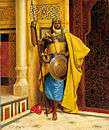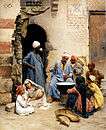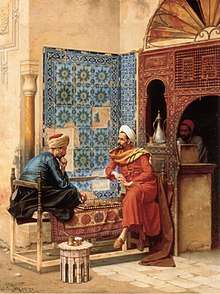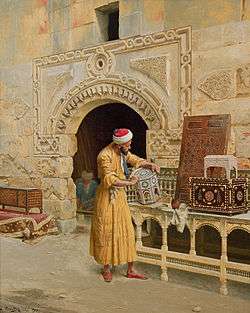Ludwig Deutsch
| Ludwig Deutsch | |
|---|---|
 The Scribe, painting by Ludwig Deutsch, 1911 | |
| Born |
1855 Vienna, Austria |
| Died |
1935 Paris, France |
| Residence | Vienna, Paris, Egypt |
| Nationality | Austrian |
| Education | Vienna Academy of Fine Arts (1872-1875) |
| Movement | Orientalism |
Ludwig Deutsch (Vienna, 1855 - Paris, 1935) was an Austrian painter who settled in Paris and became a noted Orientalist artist.
Life and career
Details of Ludwig Deutsh's life are obscure. He was born in Vienna in 1855 into a well-established Jewish family. His father was a financier at the Austrian court.[1] He studied at the Vienna Academy of Fine Arts 1872-1875, then, in 1878, moved to Paris where he became strongly associated with Orientalism.
He received his early art training at Akademie der Bildenden Künste (Academy of Fine Arts Vienna) under the tutelage of Anselm Feuerbach (1875-1877). In 1877, when Feuerbach retired as a teacher, Deutsch and some others students attempted to enter the class of Leopold Carl Müller, who had moved to Paris in 1876, but initially were refused entry. In 1878 Deutsch was finally accepted. At around this time, he may also have studied with Jean-Paul Laurens.[2] In Paris, Deutsch made the acqaintance of artists, Arthur von Ferraris, Jean Discart and Rudolf Ernst, who became his lifelong friend.[3][4] Through these friendships, Deutsch developed an interest in Orientalist art. His first Orientalist painting was produced in 1881, some years before his first visit to Egypt.[5]
In around 1880, he broke his contacts with Vienna and settled in Paris. He established a studio at Rue Le Pelletier in Paris and began to exhibit paintings with much success.[6]
Throughout the 1890s, he visited Egypt at least three times. Like many of his contemporaries, he found inspiration in the North African light, colours, scenery and customs. He collected a vast quantity of Oriental objects, including tiles, furniture, arms, pipes, fabrics, and costumes which he would subsequently used in his paintings.[7]
Work
His early work focussed primarily on historical subjects, but after visiting Egypt, he concentrated on Orientalist scenes. He was particularly interested in capturing the rich, opulent scenes of the Palace and its environs. The detail in his paintings is excellent. He was prolific, producing many paintings with the same theme - prayers, guards, musicians, street vendors etc.[8] In order to produce paintings in large volume, he created a virtual assembly line approach, using the same settings with different subjects and activities to create an impression of variety.[9] Many of Ludwig Deutsch's paintings are now in the Shafik Gabr Collection.[10] Amongst his best known works are: The Scribe,and Musical Interlude. His works are considered to be among the most sought after by collectors.[11]
Like many of his contemporaries, including Rudolf Ernst and Jean-Léon Gérôme, Deutsch made extensive use of photography to ensure archaeological accuracy in his painted renderings of local architectural features (e.g. tiles, ablaq stone work, and the traditional mashrabiyyah woodwork) in what has been described as documentary realism. This allowed him to use the Orient as inspiration, but to produce most of his paintings in his Paris studio .[12]
Selected paintings
 The Nubian Palace Guard, date unknown
The Nubian Palace Guard, date unknown The Inspection, 1883
The Inspection, 1883 The Sahleb Vendorm 1886
The Sahleb Vendorm 1886 The Chess Game, 1896
The Chess Game, 1896 In the Madrasa, c.1900
In the Madrasa, c.1900 The Smoker, 1903
The Smoker, 1903 The Furniture Maker, 1900
The Furniture Maker, 1900
Select list of paintings
- The Domino Players,' ' 1882
- An Orientalist Amateur, 1883 (Painting exhibited at the Salon of French Artists, and now presumed lost)
- The Musician, 1883
- The Sentinel, 1885
- News from Sudan, 1885
- The Answer, 1886
- The Sherbert Vendor, 1886
- The Hour of Prayer,';' 1887
- The Snake Charmers, 1888
- Court of El Azhar University, Cairo, 1890
- The Healer, 1891
- The Orange Seller, 1892
- The Palace Guard, 1892
- The Emir's Guard, 1893
- The Scribe, 1894
- The Scholar, 1895
- The Chess Game 1896
- The Philosopher, 1897
- The Offering, 1897
- Prayer at the Tomb,' 1898
- Leaving the Mosque, 1900
- The Learned, 1900
- Interior of Mosque, 1902
- The Harem Watchman 1903
- The Koran School, 1905
- Morning Prayer, 1906
- The Narghil Smoker, 1907
- Le Maitre, 1907
- The Procession of the Mahmal through the Streets of Cario, 1909
- At Prayer, 1911
- The Scribe, 1911
- The Treasure Chest, 1920
- At Prayer, 1923
- The Fortune Teller, 1927
- Musical Interlude, 1932
| Wikimedia Commons has media related to Orientalist paintings by Ludwig Deutsch. |
See also
References
- ↑ Les Orientalistes des écoles allemande et autrichienne: Martina Haja, Günther Wimmer - 2000 "Par leur caractère inachevé, elles nous placent au cœur du processus de création de Deutsch. Né à Vienne le 13 mai 1855, Ludwig Deutsch est issu d'une famille juive ; son père était changeur à la Cour impériale. Après le lycée, il entra à ."
- ↑ Thornton, L., The Orientalists: Painter-travellers, 1828-1908, Volume 1, ACR Édition, 1983, p. 210
- ↑ Orientalism: Delacroix to Klee Roger Benjamin, Mounira Khemir, Ursula Prunster - 1997 "Rudolph Ernst, like his friend Ludwig Deutsch, was a Viennese-born Orientalist who settled in Paris during the 1870s."
- ↑ Hali, The international magazine of antique carpet and textile art: Volume 8 1986 "Ludwig Deutsch is perhaps the Austrian Orientalist most sought after by collectors. One of his works on show, 'The Scholar', is a fine example of the artist at his very best. Dated 1901 and painted in Paris, like the vast majority of his works, it has ..."
- ↑ Weeks, E.M., "Ludwig Deutsch," [Catalog Note], Bonhams, Online: https://www.bonhams.com/auctions/24213/lot/48/
- ↑ Orientalism: Delacroix to Klee Roger Benjamin, Mounira Khemir, Ursula Prunster - 1997 "Rudolph Ernst, like his friend Ludwig Deutsch, was a Viennese-born Orientalist who settled in Paris during the 1870s."
- ↑ AlSayyad, N., Bierman, I.A. and Rabbat, N., Making Cairo Medieval, Lexington Books, 2005, p. 117
- ↑ Netton, I.T., Orientalism Revisited: Art, Land and Voyage, Routledge, 2012, p. 123
- ↑ AlSayyad, N., Bierman, I.A. and Rabbat, N., Making Cairo Medieval, Lexington Books, 2005, p. 117
- ↑ Gabr, S., Shafik Gabr: Masterpieces of Orientalist Art: The Shafik Gabr Collection, ACR edition, 2012
- ↑ Hali, The international magazine of antique carpet and textile art: Volume 8 1986 "Ludwig Deutsch is perhaps the Austrian Orientalist most sought after by collectors. One of his works on show, The Scholar. is a fine example of the artist at his very best. Dated 1901 and painted in Paris, like the vast majority of his works, it has ..."
- ↑ Behdad, A., Camera Orientalis: Reflections on Photography of the Middle East, University of Chicago Press, 2016, p. 25; Behdad, A, and Gartlanm (eds)., Photography's Orientalism: New Essays on Colonial Representation, Getty Publications, p. 16